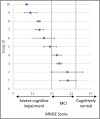Systematic Review of miRNA as Biomarkers in Alzheimer's Disease
- PMID: 30734227
- PMCID: PMC6682547
- DOI: 10.1007/s12035-019-1500-y
Systematic Review of miRNA as Biomarkers in Alzheimer's Disease
Abstract
Currently there are 850,000 people with Alzheimer's disease in the UK, with an estimated rise to 1.1 million by 2025. Alzheimer's disease is characterised by the accumulation of amyloid-beta plaques and hyperphosphorylated tau in the brain causing a progressive decline in cognitive impairment. Small non-coding microRNA (miRNA) sequences have been found to be deregulated in the peripheral blood of Alzheimer patients. A systematic review was conducted to extract all miRNA found to be significantly deregulated in the peripheral blood. These deregulated miRNAs were cross-referenced against the miRNAs deregulated in the brain at Braak Stage III. This resulted in a panel of 10 miRNAs (hsa-mir-107, hsa-mir-26b, hsa-mir-30e, hsa-mir-34a, hsa-mir-485, hsa-mir200c, hsa-mir-210, hsa-mir-146a, hsa-mir-34c, and hsa-mir-125b) hypothesised to be deregulated early in Alzheimer's disease, nearly 20 years before the onset of clinical symptoms. After network analysis of the 10 miRNAs, they were found to be associated with the immune system, cell cycle, gene expression, cellular response to stress, neuron growth factor signalling, wnt signalling, cellular senescence, and Rho GTPases.
Keywords: Alzheimer disease; Biomarkers; Brain; Peripheral blood; miRNA.
Figures






 ) targets (
) targets ( )
)
References
-
- McKhann G, Drachman D, Folstein M, Katzman R, Price D, Stadlan EM. Clinical diagnosis of Alzheimer’s disease: report of the NINCDS-ADRDA Work Group under the auspices of Department of Health and Human Services Task Force on Alzheimer’s Disease. Neurology. 1984;34(7):939–944. - PubMed
-
- Anna Dowrick AS. Dementia 2014 opportunity for change report. Editor: A.s. Society; 2014.
-
- Team, O.P.a.D., Prime minister’s challenge on dementia, D.o. Health, Editor. 2012.
-
- Ohm TG, Müller H, Braak H, Bohl J. Close-meshed prevalence rates of different stages as a tool to uncover the rate of Alzheimer’s disease-related neurofibrillary changes. Neuroscience. 1995;64(1):209–217. - PubMed
Publication types
MeSH terms
Substances
LinkOut - more resources
Full Text Sources
Other Literature Sources
Medical

